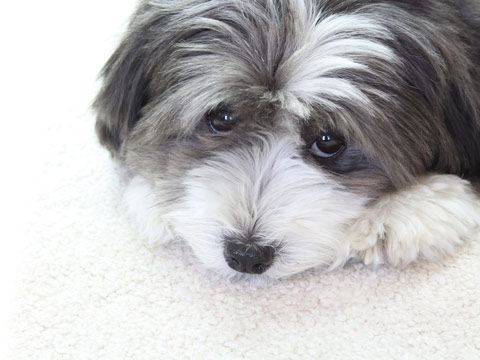A New Dog Bowel Obstruction Risk You Need to Know About

Many dogs are extremely food oriented. You know the type: garbage pickers, sandwich stealers, and counter surfers. Anything that smells like food goes down the hatch faster than you could imagine.
Many times, there's no negative repercussion when a dog eats some of your food other than there being less for you. However, there are several occasions when this type of behavior could be seriously detrimental to your dog.
How Can Eating Human Food Harm My Dog?
There are four main ways in which a dog that is prone to stealing or being fed human food can be endangered.
- Gastrointestinal disruption can occur because the dog's system isn't used to the food that's been ingested. This can result in vomiting and diarrhea that is usually short-lived but can sometimes require support in the form of fluids or medication to resolve. Veterinarians commonly call this condition "dietary indiscretion."
- Pancreatitis is a potentially life-threatening inflammation of the pancreas gland that dogs may develop from eating human foods, especially those that are high in fat.
- Toxicity is possible if your dog eats a human food that is toxic to her. Dogs have different metabolisms, enzymes, and bodily processes, and some foods that are innocuous to humans are toxic to them. You can learn more in this slideshow: "Foods Toxic to Dogs: A Slideshow."
- Intestinal obstruction occurs when something that a dog has eaten gets stuck somewhere in her gastrointestinal tract. This occurs most commonly with items like toys, cotton, corncobs, and bones.
The "New" Foreign Body Obstruction Threat
Silicone cupcake liners (and silicone bakeware in general) are being used more commonly by cooks all over America. They're reusable, easily cleaned, non-toxic, and promote even cooking. It's a win-win situation for bakers.
However, the increase in the use of silicone cupcake liners is resulting in cases of dog bowel obstruction. Here's how it happens: a dog jumps on the counter to snatch a cooling cupcake and swallows it whole, liner and all. Veterinarians are now removing more of these liners from dogs' GI tracts.
Signs of Silicone Cupcake Liner Obstruction in Dogs
If your dog ingests and becomes obstructed by a silicone cupcake liner, the signs will be similar to those that occur from any type of gastrointestinal obstruction.
- Decreased or absent appetite
- Vomiting
- Signs of abdominal pain
- Diarrhea or no stool production
Sometimes an owner is aware that their dog ate a cupcake, liner and all. Other times, they might not have realized that the sweet treat is missing.
Because they are fairly small, liners can also result in a partial obstruction. Some food is getting past the blockage, but not everything. These dogs may have more mild signs than dogs with full obstructions: they may have a decent appetite, vomit more occasionally, and generally not act as ill as dogs with full obstructions. These dogs may be sick for weeks before the problem can be nailed down.
Another scenario that can happen when a dog eats a silicone baking cup is that it stays in the stomach, not causing any real difficulty, for weeks before it finally moves into the intestinal tract and results in an obstruction. The long time period between the ingestion and the signs of illness can make it difficult for an owner to connect the two events, even if they were aware that the dog ate a cupcake.
If your dog is showing any signs of illness, even mild ones, call your veterinarian for instructions. Do not give any human medications to your dog without speaking with your veterinarian first.
Diagnosis of Canine Silicone Cupcake Liner Obstruction
If your dog is showing signs of intestinal obstruction, your veterinarian will diagnose it through a combination of history-taking, examination, and diagnostic tests. Some of the tests that may be run on your dog during the diagnostic period are listed here.
- Blood work may be done to look for other causes of vomiting.
- X-rays can show a gas pattern in the stomach or intestines that will cause the veterinarian to suspect an obstruction.
- Ultrasound may be done on the dog's abdomen to look for a blockage.
- Barium study is sometimes performed when a veterinarian is suspicious of an intestinal blockage but can't see it for sure on a plain x-ray. The dog is fed barium, which is easily seen on an x-ray. Serial x-rays are then performed. If the x-rays show that the barium stops moving through the intestinal tract, it is indicative of an obstruction.
- Abdominal exploratory surgery may be done in one of two instances: the veterinarian is fairly sure that there is an obstruction in the intestines causing the dog's clinical signs but hasn't been able to prove it with the above tests, or the doctor has not found any evidence of obstruction during testing and wants to look for the cause of the signs directly.
Treatment of Bowel Obstruction in Dogs
Dogs with partial or complete obstruction of the intestinal tract, whether from silicone baking liners or some other object, require surgery to remove the blockage.
If the obstruction has been present for a while, part of the intestine may have lost its blood supply and died. Such intestine will need to be surgically removed along with the foreign object, and the healthy intestine around it sewn together.
Intestine that has died may also rupture, leaking gut contents into the dog's abdomen, resulting in the need for massive surgical rinsing followed by aggressive fluid and antibiotic therapy for the dog.
Prevention of Silicone Cupcake Liner Obstruction in Dogs
If you bake and have a dog, be aware that silicone baking liners can cause an intestinal obstruction when canine family members eat them. Consider paper liners instead.
If you do use silicone baking liners, keep baked goods well out of your dog's reach, even when they have just come out of the oven and are cooling, or restrict your dog's access to the kitchen while the liners are in use.
Always know how many cupcake liners you have and count them to be sure you aren't missing any after you've finished using them. If you can't find a liner or you know that your dog ate one, visit your veterinarian.
You May Also Like These Articles:
Bloat in Dogs: Gastric Dilatation and Volvulus (GDV)
Disclaimer: This website is not intended to replace professional consultation, diagnosis, or treatment by a licensed veterinarian. If you require any veterinary related advice, contact your veterinarian promptly. Information at DogHealth.com is exclusively of a general reference nature. Do not disregard veterinary advice or delay treatment as a result of accessing information at this site. Just Answer is an external service not affiliated with DogHealth.com.


